1980s
I Go Pogo
Your election alternative.
Posted By: Paul - Thu Oct 29, 2020 -
Comments (0)
Category: Anthropomorphism, Humor, Satire, Politics, Comics, 1980s
Have a nice day
The driver said the customer responded with one punch to his face and six to his stomach.
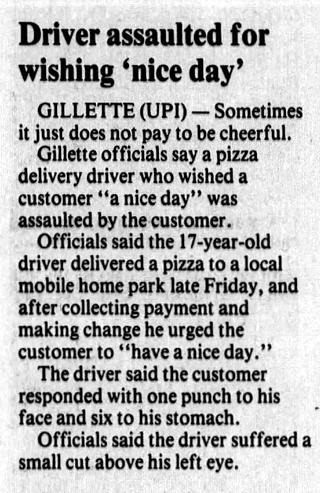
Casper Star-Tribune - Nov 23, 1983
Posted By: Alex - Sat Oct 24, 2020 -
Comments (6)
Category: Antisocial Activities, 1980s
Where Would You Hide Two Elephants?
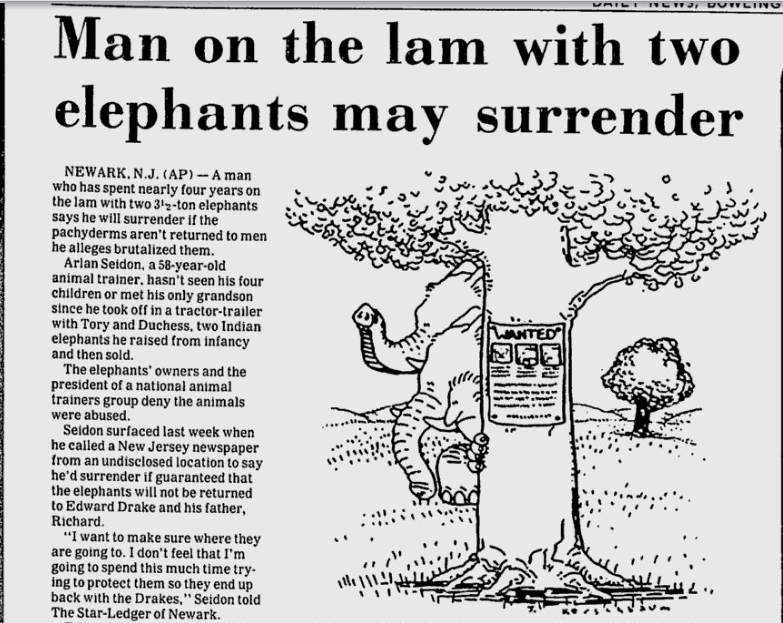
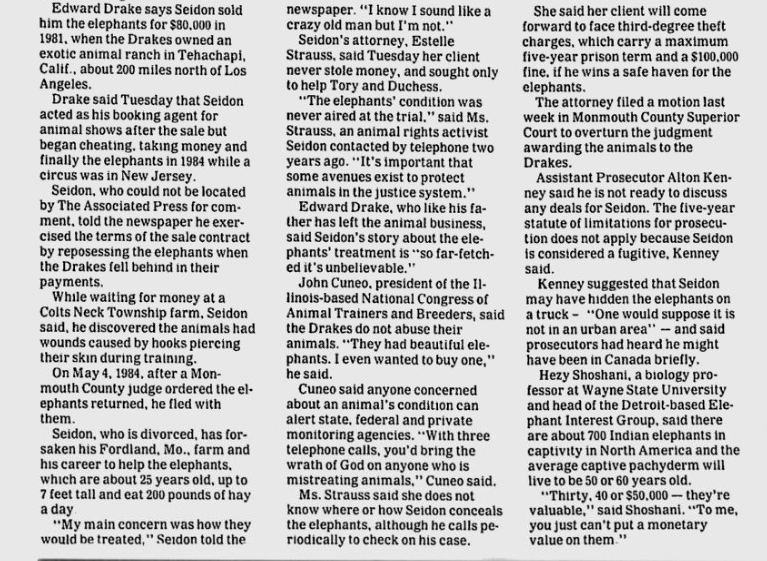
Source.
Posted By: Paul - Tue Sep 29, 2020 -
Comments (6)
Category: Animals, Crime, Eccentrics, 1980s
Killed by oranges
Weird way to die — Ingrid Kerztin was walking by the side of the road, minding her own business, when suddenly 16 tons of oranges landed on top of her, crushing her to death.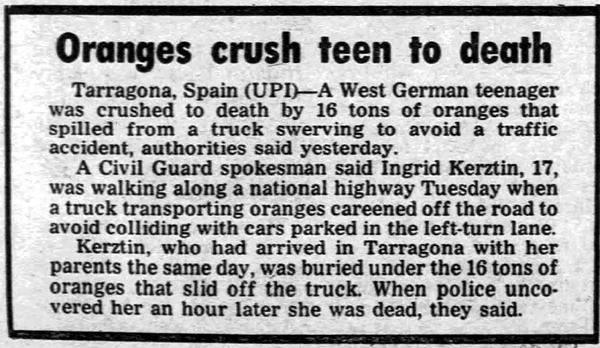
New York Daily News - July 5, 1984
Posted By: Alex - Thu Sep 17, 2020 -
Comments (4)
Category: Death, 1980s
Remove the braces, or else…
I'm sure this must have been the strangest day in Norman Carstens' career as an orthodontist:"I had him in the chair and he leaned over and pulled the gun out of his pocket and said, 'Would this make you change your mind?' and I said, 'Yes,'" Carstens said.
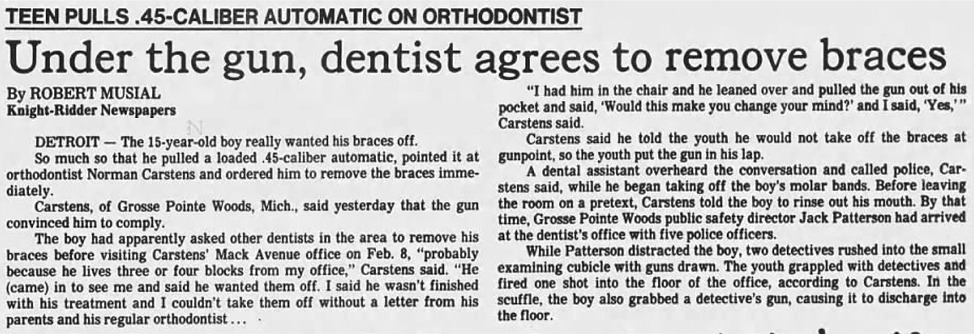
(click to enlarge)
Central New Jersey Home News - Feb 16, 1985
Posted By: Alex - Thu Sep 10, 2020 -
Comments (0)
Category: 1980s, Weapons, Teeth
Aroma Discs
Donald Spector received a patent for these in 1985. They looked like small music discs. But instead of producing sound, they released an aromatic vapor when put in the 'player'.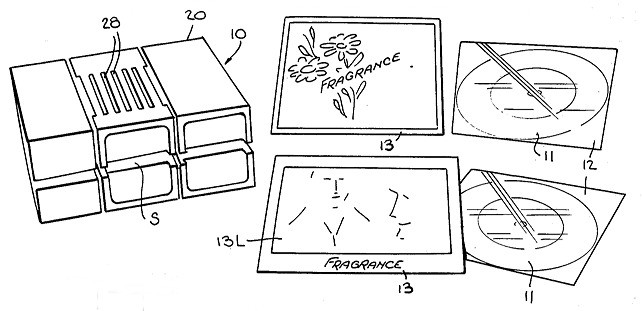
I don't see what advantage an aroma disc would have over an incense candle (except, perhaps, for the lack of an open flame). Which, I assume, is why these are no longer around and incense candles are all over the place.
But Spector was successful enough to have his product featured on The Tonight Show with Johnny Carson:
Posted By: Alex - Sun Sep 06, 2020 -
Comments (3)
Category: Inventions, Patents, 1980s, Perfume and Cologne and Other Scents
Potato Ice Cream
Idaho farmer Alan Reed invented Potato Ice Cream in the mid-1980s. This wasn't potato-flavored ice cream. Instead, it was ice cream that included potatoes (in addition to dairy) as an ingredient. The advantage of this was that the potatoes sweetened the ice cream, eliminating the need to add sugar. The result was a lower-calorie, sugar-free ice cream. Reed claimed it tasted as good as regular ice cream.However, Reed had trouble getting his potato ice cream distributed, so he sold the formula and marketing rights in 1988 to businessmen Rich Davis and James McFrederick. I assume (because I've never seen potato ice cream in a store) that they didn't manage to make a go of it either. The fact that there were better (or cheaper) sugar substitutes probably doomed Potato Ice Cream.
Reed is still operating his dairy farm and selling ice cream. But his website makes no mention at all of potatoes.
However, I don't think he's entirely given up on the idea of using potatoes to sweeten dairy, because his chocolate milk contains potato flakes (if you look closely at the ingredients). And this chocolate milk is sold in the gift shop of the Idaho Potato Museum.
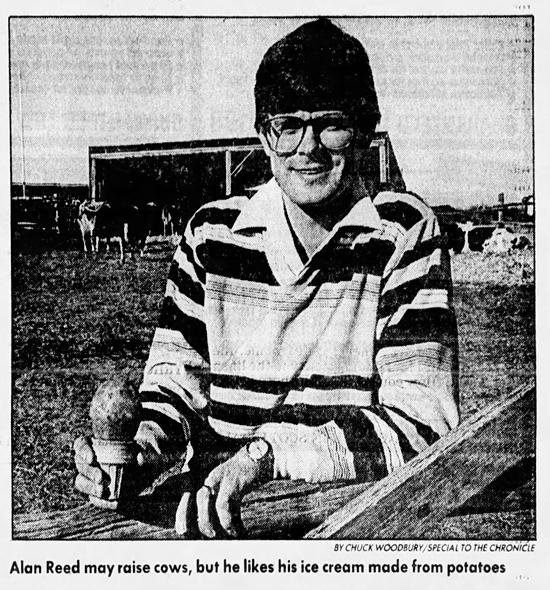
San Francisco Examiner -Dec 6, 1987
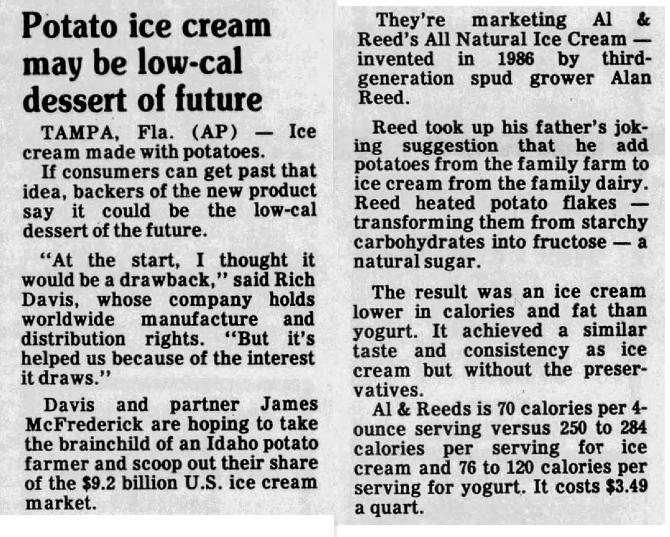
Longview Daily News - Nov 16, 1990
Posted By: Alex - Tue Sep 01, 2020 -
Comments (2)
Category: Food, 1980s
Woman vs. Bugs
October 1985: Deciding that a single can of bug spray hadn't been enough, Marilyn Lucas set off 15 cans simultaneously. The resulting explosion blew the roof off her house. The bugs survived.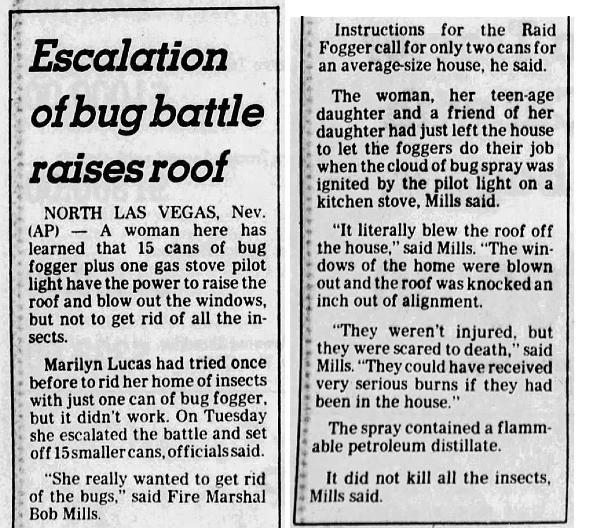
Fort Worth Star Telegram - Oct 30, 1985
Posted By: Alex - Mon Aug 31, 2020 -
Comments (6)
Category: Insects and Spiders, 1980s
Aroma of Cocaine
In 1981, Warren Woodford of Atlanta, Georgia was granted a patent (No. 4,260,517) for a method of producing the "aroma of cocaine". From the patent:Olfactory conditioning by brain trigger stimulus has recently found application in law enforcement agencies. In some instances, narcotics officers are permitted to light a marijuana cigarette during their training in order to allow them to later react to the characteristic aroma of marijuana smoke. Similarly, officers may be exposed to the aroma of cocaine so as to familiarize them with its distinctive aromatic smell...
Due to the legally controlled nature of such substances as cocaine and marijuana, it is usually not possible to freely disseminate samples of such substances to everyone who might wish to become acquainted with the aromas of these substances. Drug familiarization programs have as a result been limited by the availability of the drugs themselves.
It is therefore desirable to find alternative sources for the aroma of certain controlled substances.
I'm surprised this was never turned into a perfume.
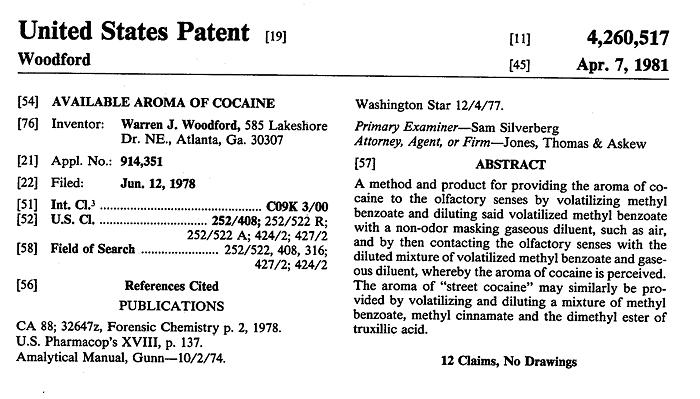
Posted By: Alex - Sun Aug 30, 2020 -
Comments (2)
Category: Drugs, Patents, 1980s, Perfume and Cologne and Other Scents
Willem de Kooning toilet seat
By the mid-1980s, works by Willem de Kooning were fetching over a million dollars. So when James Garcia and Joseph Lada found a three-hole outhouse seat stored in their basement that apparently had been painted by de Kooning, they figured they had a potential masterpiece on their hands. De Kooning's wife confirmed he had painted the toilet seat "very fast" for a croquet party in 1954. He had been trying to make the wood look like marble.The sale raised the question: was this really art? Some said no. Others, such as de Kooning's friend John MacWhinnie, argued that, "It's a youthful, exuberant example of the painter at the height of his abstract expressionism... In spite of itself, it became art, simply out of a choice the de Kooning made."
It ended up selling for $50.
More info: Baltimore Sun
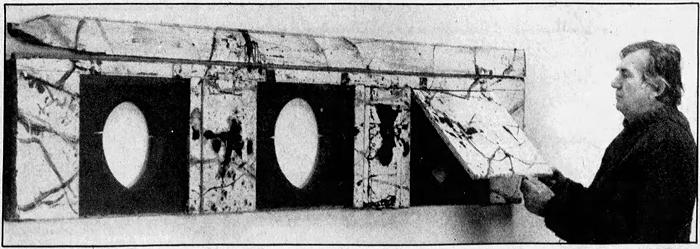
Tampa Bay Times - Feb 3, 1985
Posted By: Alex - Fri Aug 28, 2020 -
Comments (1)
Category: Art, 1980s

| Who We Are |
|---|
| Alex Boese Alex is the creator and curator of the Museum of Hoaxes. He's also the author of various weird, non-fiction, science-themed books such as Elephants on Acid and Psychedelic Apes. Paul Di Filippo Paul has been paid to put weird ideas into fictional form for over thirty years, in his career as a noted science fiction writer. He has recently begun blogging on many curious topics with three fellow writers at The Inferior 4+1. Contact Us |




